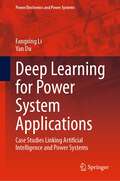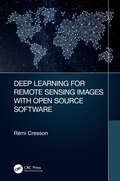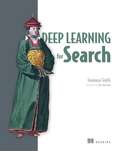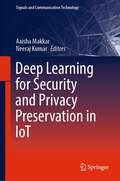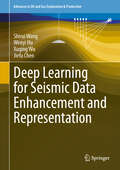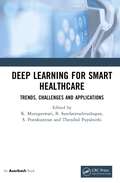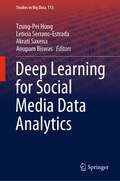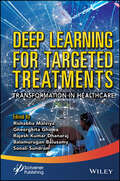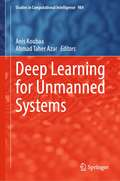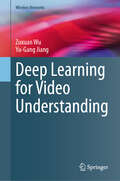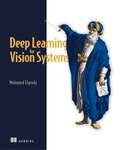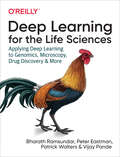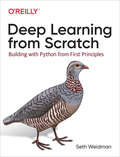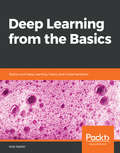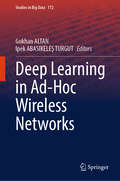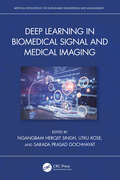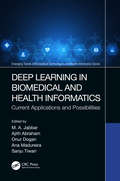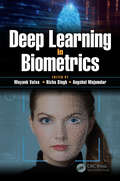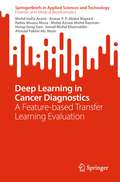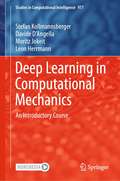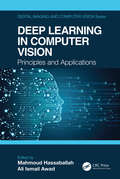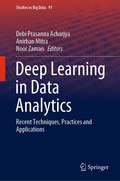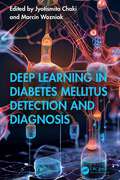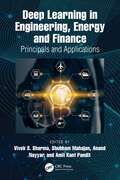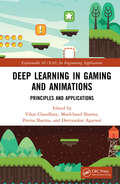- Table View
- List View
Deep Learning for Power System Applications: Case Studies Linking Artificial Intelligence and Power Systems (Power Electronics and Power Systems)
by Yan Du Fangxing LiThis book provides readers with an in-depth review of deep learning-based techniques and discusses how they can benefit power system applications. Representative case studies of deep learning techniques in power systems are investigated and discussed, including convolutional neural networks (CNN) for power system security screening and cascading failure assessment, deep neural networks (DNN) for demand response management, and deep reinforcement learning (deep RL) for heating, ventilation, and air conditioning (HVAC) control.Deep Learning for Power System Applications: Case Studies Linking Artificial Intelligence and Power Systems is an ideal resource for professors, students, and industrial and government researchers in power systems, as well as practicing engineers and AI researchers.Provides a history of AI in power grid operation and planning;Introduces deep learning algorithms and applications in power systems;Includes several representative case studies.
Deep Learning for Remote Sensing Images with Open Source Software (Signal and Image Processing of Earth Observations)
by Rémi CressonIn today’s world, deep learning source codes and a plethora of open access geospatial images are readily available and easily accessible. However, most people are missing the educational tools to make use of this resource. Deep Learning for Remote Sensing Images with Open Source Software is the first practical book to introduce deep learning techniques using free open source tools for processing real world remote sensing images. The approaches detailed in this book are generic and can be adapted to suit many different applications for remote sensing image processing, including landcover mapping, forestry, urban studies, disaster mapping, image restoration, etc. Written with practitioners and students in mind, this book helps link together the theory and practical use of existing tools and data to apply deep learning techniques on remote sensing images and data. Specific Features of this Book: The first book that explains how to apply deep learning techniques to public, free available data (Spot-7 and Sentinel-2 images, OpenStreetMap vector data), using open source software (QGIS, Orfeo ToolBox, TensorFlow) Presents approaches suited for real world images and data targeting large scale processing and GIS applications Introduces state of the art deep learning architecture families that can be applied to remote sensing world, mainly for landcover mapping, but also for generic approaches (e.g. image restoration) Suited for deep learning beginners and readers with some GIS knowledge. No coding knowledge is required to learn practical skills. Includes deep learning techniques through many step by step remote sensing data processing exercises.
Deep Learning for Search
by Tommaso TeofiliSummaryDeep Learning for Search teaches you how to improve the effectiveness of your search by implementing neural network-based techniques. By the time you're finished with the book, you'll be ready to build amazing search engines that deliver the results your users need and that get better as time goes on!Foreword by Chris Mattmann.Purchase of the print book includes a free eBook in PDF, Kindle, and ePub formats from Manning Publications.About the TechnologyDeep learning handles the toughest search challenges, including imprecise search terms, badly indexed data, and retrieving images with minimal metadata. And with modern tools like DL4J and TensorFlow, you can apply powerful DL techniques without a deep background in data science or natural language processing (NLP). This book will show you how.About the BookDeep Learning for Search teaches you to improve your search results with neural networks. You'll review how DL relates to search basics like indexing and ranking. Then, you'll walk through in-depth examples to upgrade your search with DL techniques using Apache Lucene and Deeplearning4j. As the book progresses, you'll explore advanced topics like searching through images, translating user queries, and designing search engines that improve as they learn!What's insideAccurate and relevant rankingsSearching across languagesContent-based image searchSearch with recommendationsAbout the ReaderFor developers comfortable with Java or a similar language and search basics. No experience with deep learning or NLP needed.About the AuthorTommaso Teofili is a software engineer with a passion for open source and machine learning. As a member of the Apache Software Foundation, he contributes to a number of open source projects, ranging from topics like information retrieval (such as Lucene and Solr) to natural language processing and machine translation (including OpenNLP, Joshua, and UIMA).He currently works at Adobe, developing search and indexing infrastructure components, and researching the areas of natural language processing, information retrieval, and deep learning. He has presented search and machine learning talks at conferences including BerlinBuzzwords, International Conference on Computational Science, ApacheCon, EclipseCon, and others. You can find him on Twitter at @tteofili. Table of ContentsPART 1 - SEARCH MEETS DEEP LEARNINGNeural searchGenerating synonymsPART 2 - THROWING NEURAL NETS AT A SEARCH ENGINEFrom plain retrieval to text generationMore-sensitive query suggestionsRanking search results with word embeddingsDocument embeddings for rankings and recommendationsPART 3 - ONE STEP BEYONDSearching across languagesContent-based image searchA peek at performance
Deep Learning for Security and Privacy Preservation in IoT (Signals and Communication Technology)
by Neeraj Kumar Aaisha MakkarThis book addresses the issues with privacy and security in Internet of things (IoT) networks which are susceptible to cyber-attacks and proposes deep learning-based approaches using artificial neural networks models to achieve a safer and more secured IoT environment. Due to the inadequacy of existing solutions to cover the entire IoT network security spectrum, the book utilizes artificial neural network models, which are used to classify, recognize, and model complex data including images, voice, and text, to enhance the level of security and privacy of IoT. This is applied to several IoT applications which include wireless sensor networks (WSN), meter reading transmission in smart grid, vehicular ad hoc networks (VANET), industrial IoT and connected networks. The book serves as a reference for researchers, academics, and network engineers who want to develop enhanced security and privacy features in the design of IoT systems.
Deep Learning for Seismic Data Enhancement and Representation (Advances in Oil and Gas Exploration & Production)
by Jiefu Chen Xuqing Wu Shirui Wang Wenyi HuSeismic imaging is a key component of subsurface exploration, and it depends on a high-quality seismic data acquisition system with effective seismic processing algorithms. Seismic data quality concerns various factors such as acquisition design, environmental constraints, sampling resolution, and noises. The focus of this book is to investigate efficient seismic data representation and signal enhancement solutions by leveraging the powerful feature engineering capability of deep learning. The book delves into seismic data representation and enhancement issues, ranging from seismic acquisition design to subsequent quality improvement and compression technologies. Given the challenges of obtaining suitable labeled training datasets for seismic data processing problems, we concentrate on exploring deep learning approaches that eliminate the need for labels. We combined novel deep learning techniques with conventional seismic data processing methods, and construct networks and frameworks tailored for seismic data processing. The editors and authors of this book come from both academia and industry with hands-on experiences in seismic data processing and imaging.
Deep Learning for Smart Healthcare: Trends, Challenges and Applications
by S. Poonkuntran B. Sundaravadivazhagan K. Murugeswari Thendral PuyalnithiDeep learning can provide more accurate results compared to machine learning. It uses layered algorithmic architecture to analyze data. It produces more accurate results since learning from previous results enhances its ability. The multi-layered nature of deep learning systems has the potential to classify subtle abnormalities in medical images, clustering patients with similar characteristics into risk-based cohorts, or highlighting relationships between symptoms and outcomes within vast quantities of unstructured data.Exploring this potential, Deep Learning for Smart Healthcare: Trends, Challenges and Applications is a reference work for researchers and academicians who are seeking new ways to apply deep learning algorithms in healthcare, including medical imaging and healthcare data analytics. It covers how deep learning can analyze a patient’s medical history efficiently to aid in recommending drugs and dosages. It discusses how deep learning can be applied to CT scans, MRI scans and ECGs to diagnose diseases. Other deep learning applications explored are extending the scope of patient record management, pain assessment, new drug design and managing the clinical trial process.Bringing together a wide range of research domains, this book can help to develop breakthrough applications for improving healthcare management and patient outcomes.
Deep Learning for Social Media Data Analytics (Studies in Big Data #113)
by Tzung-Pei Hong Anupam Biswas Leticia Serrano-Estrada Akrati SaxenaThis edited book covers ongoing research in both theory and practical applications of using deep learning for social media data. Social networking platforms are overwhelmed by different contents, and their huge amounts of data have enormous potential to influence business, politics, security, planning and other social aspects. Recently, deep learning techniques have had many successful applications in the AI field. The research presented in this book emerges from the conviction that there is still much progress to be made toward exploiting deep learning in the context of social media data analytics. It includes fifteen chapters, organized into four sections that report on original research in network structure analysis, social media text analysis, user behaviour analysis and social media security analysis. This work could serve as a good reference for researchers, as well as a compilation of innovative ideas and solutions for practitioners interested in applying deep learning techniques to social media data analytics.
Deep Learning for Targeted Treatments: Transformation in Healthcare
by Balamurugan Balusamy Gheorghita Ghinea Rajesh Kumar Dhanaraj Rishabha Malviya Sonali SundramDEEP LEARNING FOR TREATMENTS The book provides the direction for future research in deep learning in terms of its role in targeted treatment, biological systems, site-specific drug delivery, risk assessment in therapy, etc. Deep Learning for Targeted Treatments describes the importance of the deep learning framework for patient care, disease imaging/detection, and health management. Since deep learning can and does play a major role in a patient’s healthcare management by controlling drug delivery to targeted tissues or organs, the main focus of the book is to leverage the various prospects of the DL framework for targeted therapy of various diseases. In terms of its industrial significance, this general-purpose automatic learning procedure is being widely implemented in pharmaceutical healthcare. Audience The book will be immensely interesting and useful to researchers and those working in the areas of clinical research, disease management, pharmaceuticals, R&D formulation, deep learning analytics, remote healthcare management, healthcare analytics, and deep learning in the healthcare industry.
Deep Learning for Unmanned Systems (Studies in Computational Intelligence #984)
by Anis Koubaa Ahmad Taher AzarThis book is used at the graduate or advanced undergraduate level and many others. Manned and unmanned ground, aerial and marine vehicles enable many promising and revolutionary civilian and military applications that will change our life in the near future. These applications include, but are not limited to, surveillance, search and rescue, environment monitoring, infrastructure monitoring, self-driving cars, contactless last-mile delivery vehicles, autonomous ships, precision agriculture and transmission line inspection to name just a few. These vehicles will benefit from advances of deep learning as a subfield of machine learning able to endow these vehicles with different capability such as perception, situation awareness, planning and intelligent control. Deep learning models also have the ability to generate actionable insights into the complex structures of large data sets. In recent years, deep learning research has received an increasing amount of attention from researchers in academia, government laboratories and industry. These research activities have borne some fruit in tackling some of the challenging problems of manned and unmanned ground, aerial and marine vehicles that are still open. Moreover, deep learning methods have been recently actively developed in other areas of machine learning, including reinforcement training and transfer/meta-learning, whereas standard, deep learning methods such as recent neural network (RNN) and coevolutionary neural networks (CNN). The book is primarily meant for researchers from academia and industry, who are working on in the research areas such as engineering, control engineering, robotics, mechatronics, biomedical engineering, mechanical engineering and computer science. The book chapters deal with the recent research problems in the areas of reinforcement learning-based control of UAVs and deep learning for unmanned aerial systems (UAS)The book chapters present various techniques of deep learning for robotic applications. The book chapters contain a good literature survey with a long list of references.The book chapters are well written with a good exposition of the research problem, methodology, block diagrams and mathematical techniques.The book chapters are lucidly illustrated with numerical examples and simulations.The book chapters discuss details of applications and future research areas.
Deep Learning for Video Understanding (Wireless Networks)
by Zuxuan Wu Yu-Gang JiangThis book presents deep learning techniques for video understanding. For deep learning basics, the authors cover machine learning pipelines and notations, 2D and 3D Convolutional Neural Networks for spatial and temporal feature learning. For action recognition, the authors introduce classical frameworks for image classification, and then elaborate both image-based and clip-based 2D/3D CNN networks for action recognition. For action detection, the authors elaborate sliding windows, proposal-based detection methods, single stage and two stage approaches, spatial and temporal action localization, followed by datasets introduction. For video captioning, the authors present language-based models and how to perform sequence to sequence learning for video captioning. For unsupervised feature learning, the authors discuss the necessity of shifting from supervised learning to unsupervised learning and then introduce how to design better surrogate training tasks to learn video representations. Finally, the book introduces recent self-training pipelines like contrastive learning and masked image/video modeling with transformers. The book provides promising directions, with an aim to promote future research outcomes in the field of video understanding with deep learning.
Deep Learning for Vision Systems
by Mohamed ElgendyHow does the computer learn to understand what it sees? Deep Learning for Vision Systems answers that by applying deep learning to computer vision. Using only high school algebra, this book illuminates the concepts behind visual intuition. You'll understand how to use deep learning architectures to build vision system applications for image generation and facial recognition.Summary Computer vision is central to many leading-edge innovations, including self-driving cars, drones, augmented reality, facial recognition, and much, much more. Amazing new computer vision applications are developed every day, thanks to rapid advances in AI and deep learning (DL). Deep Learning for Vision Systems teaches you the concepts and tools for building intelligent, scalable computer vision systems that can identify and react to objects in images, videos, and real life. With author Mohamed Elgendy's expert instruction and illustration of real-world projects, you&’ll finally grok state-of-the-art deep learning techniques, so you can build, contribute to, and lead in the exciting realm of computer vision! Purchase of the print book includes a free eBook in PDF, Kindle, and ePub formats from Manning Publications. About the technology How much has computer vision advanced? One ride in a Tesla is the only answer you&’ll need. Deep learning techniques have led to exciting breakthroughs in facial recognition, interactive simulations, and medical imaging, but nothing beats seeing a car respond to real-world stimuli while speeding down the highway. About the book How does the computer learn to understand what it sees? Deep Learning for Vision Systems answers that by applying deep learning to computer vision. Using only high school algebra, this book illuminates the concepts behind visual intuition. You'll understand how to use deep learning architectures to build vision system applications for image generation and facial recognition. What's inside Image classification and object detection Advanced deep learning architectures Transfer learning and generative adversarial networks DeepDream and neural style transfer Visual embeddings and image search About the reader For intermediate Python programmers. About the author Mohamed Elgendy is the VP of Engineering at Rakuten. A seasoned AI expert, he has previously built and managed AI products at Amazon and Twilio. Table of Contents PART 1 - DEEP LEARNING FOUNDATION 1 Welcome to computer vision 2 Deep learning and neural networks 3 Convolutional neural networks 4 Structuring DL projects and hyperparameter tuning PART 2 - IMAGE CLASSIFICATION AND DETECTION 5 Advanced CNN architectures 6 Transfer learning 7 Object detection with R-CNN, SSD, and YOLO PART 3 - GENERATIVE MODELS AND VISUAL EMBEDDINGS 8 Generative adversarial networks (GANs) 9 DeepDream and neural style transfer 10 Visual embeddings
Deep Learning for the Life Sciences: Applying Deep Learning to Genomics, Microscopy, Drug Discovery, and More
by Peter Eastman Bharath Ramsundar Vijay Pande Pat WaltersDeep learning has already achieved remarkable results in many fields. Now it’s making waves throughout the sciences broadly and the life sciences in particular. This practical book teaches developers and scientists how to use deep learning for genomics, chemistry, biophysics, microscopy, medical analysis, and other fields.Ideal for practicing developers and scientists ready to apply their skills to scientific applications such as biology, genetics, and drug discovery, this book introduces several deep network primitives. You’ll follow a case study on the problem of designing new therapeutics that ties together physics, chemistry, biology, and medicine—an example that represents one of science’s greatest challenges.Learn the basics of performing machine learning on molecular dataUnderstand why deep learning is a powerful tool for genetics and genomicsApply deep learning to understand biophysical systemsGet a brief introduction to machine learning with DeepChemUse deep learning to analyze microscopic imagesAnalyze medical scans using deep learning techniquesLearn about variational autoencoders and generative adversarial networksInterpret what your model is doing and how it’s working
Deep Learning from Scratch: Building with Python from First Principles
by Seth WeidmanWith the resurgence of neural networks in the 2010s, deep learning has become essential for machine learning practitioners and even many software engineers. This book provides a comprehensive introduction for data scientists and software engineers with machine learning experience. You’ll start with deep learning basics and move quickly to the details of important advanced architectures, implementing everything from scratch along the way.Author Seth Weidman shows you how neural networks work using a first principles approach. You’ll learn how to apply multilayer neural networks, convolutional neural networks, and recurrent neural networks from the ground up. With a thorough understanding of how neural networks work mathematically, computationally, and conceptually, you’ll be set up for success on all future deep learning projects.This book provides:Extremely clear and thorough mental models—accompanied by working code examples and mathematical explanations—for understanding neural networksMethods for implementing multilayer neural networks from scratch, using an easy-to-understand object-oriented frameworkWorking implementations and clear-cut explanations of convolutional and recurrent neural networksImplementation of these neural network concepts using the popular PyTorch framework
Deep Learning from the Basics: Python and Deep Learning: Theory and Implementation
by Koki SaitohDiscover ways to implement various deep learning algorithms by leveraging Python and other technologiesKey FeaturesLearn deep learning models through several activitiesBegin with simple machine learning problems, and finish by building a complex system of your ownTeach your machines to see by mastering the technologies required for image recognitionBook DescriptionDeep learning is rapidly becoming the most preferred way of solving data problems. This is thanks, in part, to its huge variety of mathematical algorithms and their ability to find patterns that are otherwise invisible to us. Deep Learning from the Basics begins with a fast-paced introduction to deep learning with Python, its definition, characteristics, and applications. You'll learn how to use the Python interpreter and the script files in your applications, and utilize NumPy and Matplotlib in your deep learning models. As you progress through the book, you'll discover backpropagation—an efficient way to calculate the gradients of weight parameters—and study multilayer perceptrons and their limitations, before, finally, implementing a three-layer neural network and calculating multidimensional arrays. By the end of the book, you'll have the knowledge to apply the relevant technologies in deep learning.What you will learnUse Python with minimum external sources to implement deep learning programsStudy the various deep learning and neural network theoriesLearn how to determine learning coefficients and the initial values of weightsImplement trends such as Batch Normalization, Dropout, and AdamExplore applications like automatic driving, image generation, and reinforcement learningWho this book is forDeep Learning from the Basics is designed for data scientists, data analysts, and developers who want to use deep learning techniques to develop efficient solutions. This book is ideal for those who want a deeper understanding as well as an overview of the technologies. Some working knowledge of Python is a must. Knowledge of NumPy and pandas will be beneficial, but not essential.
Deep Learning in Ad-Hoc Wireless Networks (Studies in Big Data #172)
by Gokhan Altan Ipek Abasikeleş TurgutThis book presents innovative applications of deep learning techniques in wireless ad-hoc networks, addressing critical challenges such as trust, routing, traffic management, and intrusion detection. By combining advanced AI models with real-world network scenarios, the chapters explore novel solutions for improving network reliability, security, and efficiency. Readers benefit from a multidisciplinary approach that bridges deep learning and wireless communication, offering both theoretical insights and practical frameworks. Targeting researchers, engineers, and graduate students, this work serves as a valuable resource for understanding and implementing deep learning strategies to optimize modern wireless systems. Whether improving IoT networks, securing controller area networks, or enabling smart mobility, the book provides actionable knowledge on Deep Learning applications for solving current and future challenges in ad-hoc wireless networks.
Deep Learning in Biomedical Signal and Medical Imaging (Artificial Intelligence for Sustainable Engineering and Management)
by Utku Kose Ngangbam Herojit Singh Sarada Prasad GochhayatThis book offers detailed information on biomedical imaging using Deep Convolutional Neural Networks (Deep CNN). It focuses on different types of biomedical images to enable readers to understand the effectiveness and the potential. It includes topics such as disease diagnosis and image processing perspectives.Deep Learning in Biomedical Signal and Medical Imaging discusses classification, segmentation, detection, tracking, and retrieval applications of non-invasive methods such as EEG, ECG, EMG, MRI, fMRI, CT, and X-RAY, amongst others. It surveys the most recent techniques and approaches in this field, with both broad coverage and enough depth to be of practical use to working professionals. It includes examples of the application of signal and image processing employing Deep CNN to Alzheimer’s, brain tumor, skin cancer, breast cancer, and stroke prediction, as well as ECG and EEG signals. This book offers enough fundamental and technical information on these techniques, approaches, and related problems without overcrowding the reader’s head. It presents the results of the latest investigations in the field of Deep CNN for biomedical data analysis. The techniques and approaches presented in this book deal with the most important and/or the newest topics encountered in this field. They combine the fundamental theory of artificial intelligence (AI), machine learning (ML,) and Deep CNN with practical applications in biology and medicine. Certainly, the list of topics covered in this book is not exhaustive, but these topics will shed light on the implications of the presented techniques and approaches on other topics in biomedical data analysis.The book is written for graduate students, researchers, and professionals in biomedical engineering, electrical engineering, signal process engineering, biomedical imaging, and computer science. The specific and innovative solutions covered in this book for both medical and biomedical applications are critical to scientists, researchers, practitioners, professionals, and educators who are working in the context of the topics.
Deep Learning in Biomedical and Health Informatics: Current Applications and Possibilities (Emerging Trends in Biomedical Technologies and Health informatics)
by Ajith Abraham Ana Madureira M. A. Jabbar Sanju Tiwari Onur DoganThis book provides a proficient guide on the relationship between Artificial Intelligence (AI) and healthcare and how AI is changing all aspects of the healthcare industry. It also covers how deep learning will help in diagnosis and the prediction of disease spread. The editors present a comprehensive review of research applying deep learning in health informatics in the fields of medical imaging, electronic health records, genomics, and sensing, and highlights various challenges in applying deep learning in health care. This book also includes applications and case studies across all areas of AI in healthcare data. The editors also aim to provide new theories, techniques, developments, and applications of deep learning, and to solve emerging problems in healthcare and other domains. This book is intended for computer scientists, biomedical engineers, and healthcare professionals researching and developing deep learning techniques. In short, the volume : Discusses the relationship between AI and healthcare, and how AI is changing the health care industry. Considers uses of deep learning in diagnosis and prediction of disease spread. Presents a comprehensive review of research applying deep learning in health informatics across multiple fields. Highlights challenges in applying deep learning in the field. Promotes research in ddeep llearning application in understanding the biomedical process. Dr.. M.A. Jabbar is a professor and Head of the Department AI&ML, Vardhaman College of Engineering, Hyderabad, Telangana, India. Prof. (Dr.) Ajith Abraham is the Director of Machine Intelligence Research Labs (MIR Labs), Auburn, Washington, USA. Dr.. Onur Dogan is an assistant professor at İzmir Bakırçay University, Turkey. Prof. Dr. Ana Madureira is the Director of The Interdisciplinary Studies Research Center at Instituto Superior de Engenharia do Porto (ISEP), Portugal. Dr.. Sanju Tiwari is a senior researcher at Universidad Autonoma de Tamaulipas, Mexico.
Deep Learning in Biometrics
by Richa Singh Mayank Vatsa Angshul MajumdarDeep Learning is now synonymous with applied machine learning. Many technology giants (e.g. Google, Microsoft, Apple, IBM) as well as start-ups are focusing on deep learning-based techniques for data analytics and artificial intelligence. This technology applies quite strongly to biometrics. This book covers topics in deep learning, namely convolutional neural networks, deep belief network and stacked autoencoders. The focus is also on the application of these techniques to various biometric modalities: face, iris, palmprint, and fingerprints, while examining the future trends in deep learning and biometric research. Contains chapters written by authors who are leading researchers in biometrics. Presents a comprehensive overview on the internal mechanisms of deep learning. Discusses the latest developments in biometric research. Examines future trends in deep learning and biometric research. Provides extensive references at the end of each chapter to enhance further study.
Deep Learning in Cancer Diagnostics: A Feature-based Transfer Learning Evaluation (SpringerBriefs in Applied Sciences and Technology)
by Anwar P. P. Abdul Majeed Mohd Azraai Mohd Razman Rabiu Muazu Musa Ahmad Fakhri Ab. Nasir Mohd Hafiz Arzmi Hong-Seng Gan Ismail Mohd KhairuddinCancer is the leading cause of mortality in most, if not all, countries around the globe. It is worth noting that the World Health Organisation (WHO) in 2019 estimated that cancer is the primary or secondary leading cause of death in 112 of 183 countries for individuals less than 70 years old, which is alarming. In addition, cancer affects socioeconomic development as well. The diagnostics of cancer are often carried out by medical experts through medical imaging; nevertheless, it is not without misdiagnosis owing to a myriad of reasons. With the advancement of technology and computing power, the use of state-of-the-art computational methods for the accurate diagnosis of cancer is no longer far-fetched. In this brief, the diagnosis of four types of common cancers, i.e., breast, lung, oral and skin, are evaluated with different state-of-the-art feature-based transfer learning models. It is expected that the findings in this book are insightful to various stakeholders in the diagnosis of cancer.
Deep Learning in Computational Mechanics: An Introductory Course (Studies in Computational Intelligence #977)
by Stefan Kollmannsberger Moritz Jokeit Leon Herrmann Davide D'AngellaThis book provides a first course on deep learning in computational mechanics. The book starts with a short introduction to machine learning’s fundamental concepts before neural networks are explained thoroughly. It then provides an overview of current topics in physics and engineering, setting the stage for the book’s main topics: physics-informed neural networks and the deep energy method.The idea of the book is to provide the basic concepts in a mathematically sound manner and yet to stay as simple as possible. To achieve this goal, mostly one-dimensional examples are investigated, such as approximating functions by neural networks or the simulation of the temperature’s evolution in a one-dimensional bar.Each chapter contains examples and exercises which are either solved analytically or in PyTorch, an open-source machine learning framework for python.
Deep Learning in Computer Vision: Principles and Applications (Digital Imaging and Computer Vision)
by Ali Ismail Awad Mahmoud HassaballahDeep learning algorithms have brought a revolution to the computer vision community by introducing non-traditional and efficient solutions to several image-related problems that had long remained unsolved or partially addressed. This book presents a collection of eleven chapters where each individual chapter explains the deep learning principles of a specific topic, introduces reviews of up-to-date techniques, and presents research findings to the computer vision community. The book covers a broad scope of topics in deep learning concepts and applications such as accelerating the convolutional neural network inference on field-programmable gate arrays, fire detection in surveillance applications, face recognition, action and activity recognition, semantic segmentation for autonomous driving, aerial imagery registration, robot vision, tumor detection, and skin lesion segmentation as well as skin melanoma classification. The content of this book has been organized such that each chapter can be read independently from the others. The book is a valuable companion for researchers, for postgraduate and possibly senior undergraduate students who are taking an advanced course in related topics, and for those who are interested in deep learning with applications in computer vision, image processing, and pattern recognition.
Deep Learning in Data Analytics: Recent Techniques, Practices and Applications (Studies in Big Data #91)
by Noor Zaman Debi Prasanna Acharjya Anirban MitraThis book comprises theoretical foundations to deep learning, machine learning and computing system, deep learning algorithms, and various deep learning applications. The book discusses significant issues relating to deep learning in data analytics. Further in-depth reading can be done from the detailed bibliography presented at the end of each chapter. Besides, this book's material includes concepts, algorithms, figures, graphs, and tables in guiding researchers through deep learning in data science and its applications for society.Deep learning approaches prevent loss of information and hence enhance the performance of data analysis and learning techniques. It brings up many research issues in the industry and research community to capture and access data effectively. The book provides the conceptual basis of deep learning required to achieve in-depth knowledge in computer and data science. It has been done to make the book more flexible and to stimulate further interest in topics. All these help researchers motivate towards learning and implementing the concepts in real-life applications.
Deep Learning in Diabetes Mellitus Detection and Diagnosis
by Jyotismita Chaki Marcin WozniakDeep Learning in Diabetes Mellitus Detection and Diagnosis focuses on deep learning-based approaches in the field of diabetes mellitus detection and diagnosis, including preprocessing techniques that are an essential part of this subject. This is the first book of its kind to cover deep learning-based approaches in the specific field of diabetes mellitus. This book includes a detailed introductory overview as well as chapters on current applications, preprocessing of data using deep learning, deep learning techniques, complexity, challenges, and future directions. It will be of great interest to researchers and professionals working on diabetes mellitus as well as general medical applications of machine learning.Features: Highlights how the use of deep neural networks-based applications can address new questions and protocols, as well as improve upon existing challenges in diabetes mellitus detection and diagnosis Assists scholars and students who might like to learn about this area as well as others who may have begun without a formal presentation, with no complex mathematical equations Involves exceptional subject coverage and includes the principles needed to understand deep learning
Deep Learning in Engineering, Energy and Finance: Principals and Applications
by Anand Nayyar Shubham Mahajan Amit Kant Pandit Vivek S. SharmaUnlock the transformative potential of deep learning in your professional and academic endeavors with Deep Learning in Engineering, Energy and Finance: Principals and Applications. This comprehensive guide seamlessly bridges the gap between theoretical concepts and practical implementations, providing you with the knowledge and tools to revolutionize industries and drive innovation. Delve into real-world applications and cutting-edge research that showcase how deep learning is redefining engineering processes, optimizing energy systems, and reshaping financial markets.This book: Explores deep learning applications across engineering, energy, and finance, highlighting diverse use cases and industry-specific challenges. Discovers how deep learning is driving breakthroughs in predictive maintenance, energy optimization, algorithmic trading, and risk management. Illustrates all the concepts connected to Deep Learning from head and heart with real-time practical examples and case studies. Stresses on skills needed to tackle future challenges, with a focus on emerging deep learning technologies oriented towards Solar Energy, SOM’s, Stock Market, Speech Technology and Many more. Whether you're a student eager to explore the latest advancements or a seasoned R&D professional seeking to enhance your skill set, this book offers invaluable insights and practical guidance to elevate your expertise.
Deep Learning in Gaming and Animations: Principles and Applications (Explainable AI (XAI) for Engineering Applications)
by Vikas ChaudharyOver the last decade, progress in deep learning has had a profound and transformational effect on many complex problems, including speech recognition, machine translation, natural language understanding, and computer vision. As a result, computers can now achieve human-competitive performance in a wide range of perception and recognition tasks. Many of these systems are now available to the programmer via a range of so-called cognitive services. More recently, deep reinforcement learning has achieved ground-breaking success in several complex challenges. This book makes an enormous contribution to this beautiful, vibrant area of study: an area that is developing rapidly both in breadth and depth. Deep learning can cope with a broader range of tasks (and perform those tasks to increasing levels of excellence). This book lays a good foundation for the core concepts and principles of deep learning in gaming and animation, walking you through the fundamental ideas with expert ease. This book progresses in a step-by-step manner. It reinforces theory with a full-fledged pedagogy designed to enhance students' understanding and offer them a practical insight into its applications. Also, some chapters introduce and cover novel ideas about how artificial intelligence (AI), deep learning, and machine learning have changed the world in gaming and animation. It gives us the idea that AI can also be applied in gaming, and there are limited textbooks in this area. This book comprehensively addresses all the aspects of AI and deep learning in gaming. Also, each chapter follows a similar structure so that students, teachers, and industry experts can orientate themselves within the text. There are few books in the field of gaming using AI. Deep Learning in Gaming and Animations teaches you how to apply the power of deep learning to build complex reasoning tasks. After being exposed to the foundations of machine and deep learning, you will use Python to build a bot and then teach it the game's rules. This book also focuses on how different technologies have revolutionized gaming and animation with various illustrations.
